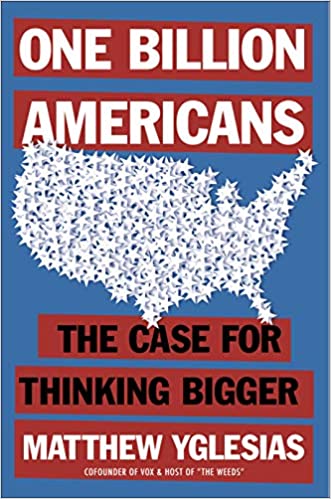You have /5 articles left.
Sign up for a free account or log in.
 One Billion Americans: The Case for Thinking Bigger by Matthew Yglesias
One Billion Americans: The Case for Thinking Bigger by Matthew Yglesias
Published in September 2020
The U.S. population is currently at about 330 million. The Census Bureau projects that the U.S. population will hit 400 million somewhere between 2050 and 2060.
Journalist Matthew Yglesias thinks that this is not enough. The title of his new book, One Billion Americans, does not mean that Yglesias thinks we should literally grow to a billion. Instead, framing the idea of population size around a billion is a rhetorical strategy, one that allows Yglesias to unpack and defuse antinatalist and anti-immigration arguments.
As an academically trained social demographer, my sympathies lie with Yglesias. As far as I can tell, we spend most of our time worrying about the wrong things. The amount of energy spent on the fear that robots will take our jobs would be better spent thinking about planning for our rapidly aging society. I worry that the U.S. is vulnerable to the same declines in total fertility that Japan, South Korea and much of Europe have already experienced.
The U.S. total fertility rate (TFR) currently stands at about 1.7, well below that required for population replacement (2.1). (TFR is the total number of births a woman is expected to have over her lifetime. A replacement TFR of 2.1 is needed to replace both parents, with a bit of wiggle room for mortality.) In many big U.S. cities, the TFR already resembles Japan's. D.C.’s TFR is 1.35. San Francisco is estimated to have more dogs than children.
Yglesias, who happily reports having one kid, is not arguing in One Billion Americans that everyone should have lots of kids. Instead, he quite rightly points out that Americans are having fewer kids than they want. Polling by Gallup has consistently demonstrated that women and men desire more kids than they have. The mismatch between fertility desires and behaviors is driven by rational economic calculations. The average cost of raising a child is over $280,000. The cost to live in a neighborhood with good schools, combined with expenses from childcare to college, have pushed many of us to limit childbearing.
For Yglesias, the decline in fertility and subsequent aging of the population is more than a problem of paying for Social Security and Medicare. (Both pay-as-we-go programs.) In One Billion Americans, Yglesias argues that the U.S. will be challenged to remain a global leader as our relative population declines. He points out that slow population growth countries have almost always been slow economic growth places as well.
What would be the livability toll should the U.S. have fast population growth -- either through immigration (more possible) or incentives to procreate (seldom very effective)? Purely measured by population density, the U.S. could absorb many more people. The United Kingdom has an average of 725 people per square mile. Japan has 863. The US has only 87.
Parts of the U.S. may feel overcrowded, but that is mostly due to restrictive zoning regulations that limit the number of apartments and housing. We have lots of room. Yglesias also takes on concerns about population growth and the environment. He recognizes that more Americans would impact carbon emissions. But he also points out that carbon emissions in wealthier countries are going down as cleaner sources of energy (gas and then renewables) replace coal.
If you worry about population growth or are skeptical of the positive impact of immigration, you are likely to be unpersuaded by One Billion Americans. On the other hand, if you are agnostic on population growth, One Billion Americans may convince you that pro-baby-making policies (from publicly supported childcare to publicly funded higher education) are a good idea.
I’d love to see higher ed people worry less about robots and more about an economy that disincentives people from having the number of kids they want. Those missing babies are our future missing students.
What are you reading?




